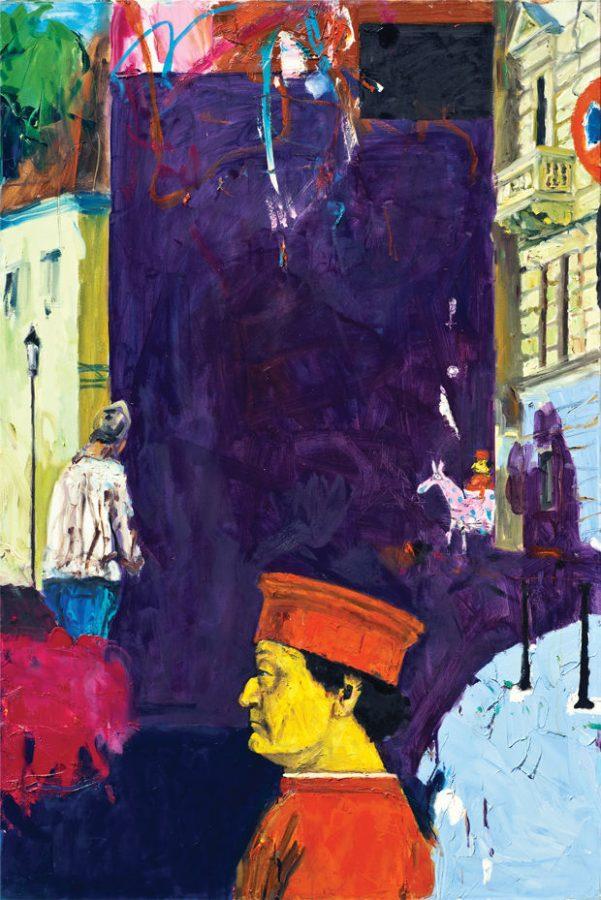Israeli painter draws on multiple art styles–and Einstein
Published March 29, 2017
Webster’s “New World College Dictionary” defines “infinity” as “endless or unlimited space, time [or] distance.” All of these qualities fit the exhibition “Leo Ray: Infinite Painting” on view through May 28 at St. Louis University Museum of Art (SLUMA).
Born in Vilnius, Lithuania, in 1950, Ray has lived in Tel Aviv since 1991. He has a background in theoretical physics as well as art and holds degrees from Vilnius University and Vilnius Academy of Arts.
The principals of theoretical physics contribute to Ray’s work as an artist.
“With regard to the relativistic theory of Einstein, time is the fourth dimension of space,” he said. “If we see a house through time, first it’s new and then it’s old. Things like this are visible in my paintings.”
The exhibition is made up of some of Ray’s earlier stand-alone works and his 98 canvas “Infinite Painting.”
Ray painted the standalone pieces in the mid-1990s. They are similar to “Infinite Painting” in terms of subject matter and style, and they demonstrate his progression as an artist.
“Infinite Painting,” the focus of the exhibition, stretches around the Aronson Gallery within the museum. Ray painted all of the canvases from 2009 to last year.
“I didn’t plan out all of them at once,” he said. “I paint three or four at a time. When I finish those, I think about what might come afterwards.”
The sequence appears to end with a big white cat that occupies five canvases. But Ray plans to add more canvases after the cat.
“I happened to stop at the cat by the time this exhibition came about, but it’s only incidental that it’s the end of the sequence,” he said.
Ray’s previous work includes a few paintings that are made up of multiple canvases.
“It was time to make something more meaningful,” he said. “The ‘Infinite Painting’ is much more substantial.”
The sequence features a stunning array of buildings, people, animals, landscapes and cityscapes in many artistic styles such as abstract and impressionistic.
“Ray makes many references to the history of art,” said Petruta Lipan, executive director of SLUMA. “He paints part of one canvas in an abstract expressionism style, and another part of the same canvas representational.”
Asked why “Infinite Painting” includes so many styles, Ray said, “That was an interesting moment in my life. What should I paint in this infinite painting? I answered my own question: ‘Everything. If it’s infinite, then everything fits.’ ”
Referring to his art history references, Ray explained, “I like Renaissance art because the artists were exceptionally good painters. Even when you just reinterpret artworks, you understand how they were made and you go into the depths of them.”
An example of Ray’s reinterpretation is a set of four canvases that play off of Renaissance artist Vittore Carpaccio’s 15th century painting “Two Venetian Ladies.” In it, two women sit next to a balustrade with two dogs and a variety of birds. Ray placed each woman on a different canvas. He extended the scene by including a canvas between the women in which a series of expressionistic figures peer over the balustrade. Carpaccio depicted only the head and paws of one of the dogs, but Ray’s fourth canvas gives the dog a body and two fantastical canine friends.
Another reinterpretation, this time contained within one canvas, focuses on the Italian Renaissance portrait of Duke Federico da Montefeltro by Piero della Francesca. The canvas is bordered by naturalistic Renaissance-style buildings at the left and right. The background is purple. Ray placed Federico in two places: his portrait is at the bottom center; and in the background, Federico rides a whimsical horse.
“Federico was an interesting person, a warrior who supported the arts,” Ray said.
The duke lost his right eye in a tournament accident. His surgeons removed his nasal bridge so he could see to his right side out of his left eye.
“We’re familiar with him from the left side, because of this portrait,” Ray said. “I put him on a horse because he was a warrior, and I painted the horse pink with blue spots because this is my favorite way to paint a horse.”
In the middle of the sequence comes a floor-to-ceiling series of blue canvases called“Sky.” The series begins at the floor with the lower level of canvases and continues to the upper level. The series may seem to begin and end abruptly, but some canvases that precede it make reference to daytime and then evening.
“Those canvases are an introduction to the silence of the night sky,” Ray said.
“Infinite Painting” was shown in Vilnius before it came to St. Louis. The process of bringing it here started approximately a year ago when Richard Winter, a local major supporter of the exhibition, approached Lipan about Ray’s work. Lipan was interested from the beginning.
“This exhibition has broad appeal,” Lipan said. “Art is key in connecting people. It is vital in this day and age to understand how much we have in common.”
Lipan, who teaches her students that artists communicate through their art, thought it was important that Ray talk to students in St. Louis about his work.
“Exposing kids to art will make them a lot more creative,” she said. “Art unleashes the imagination.”















